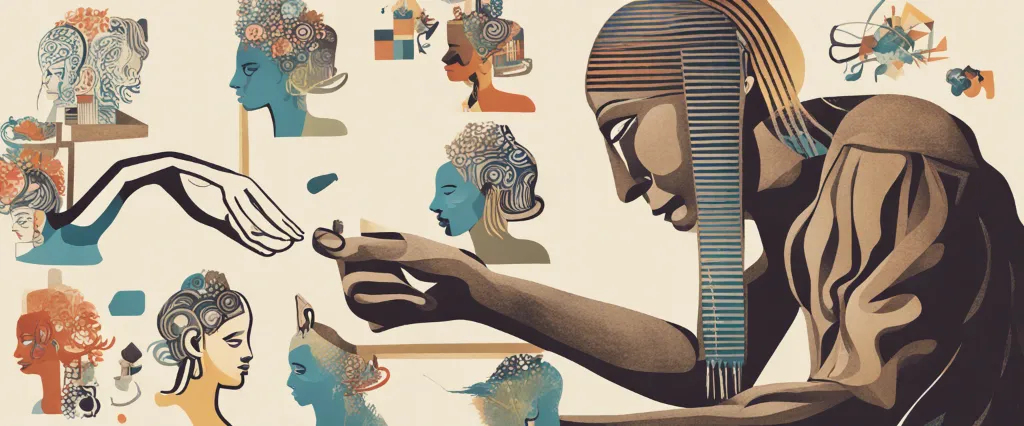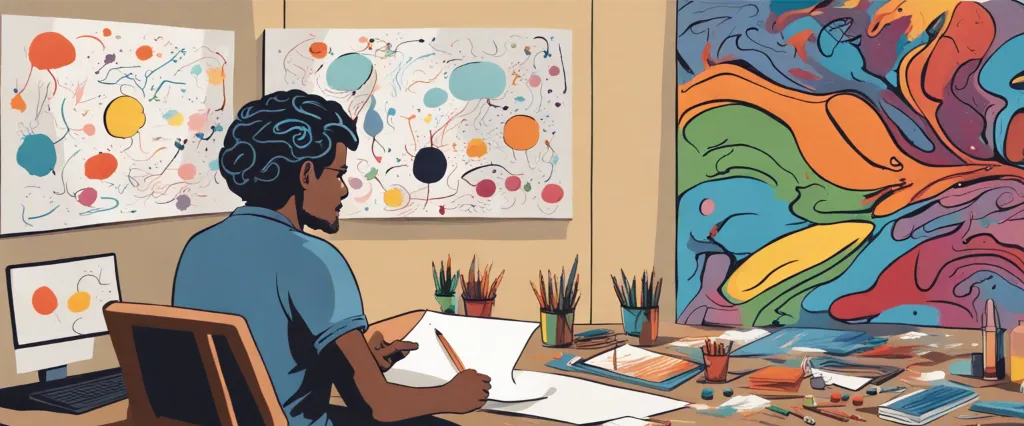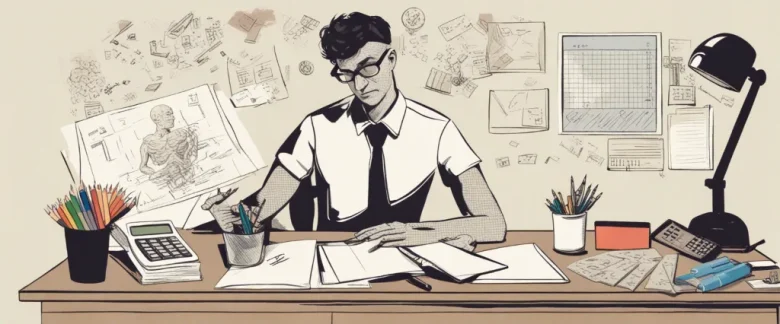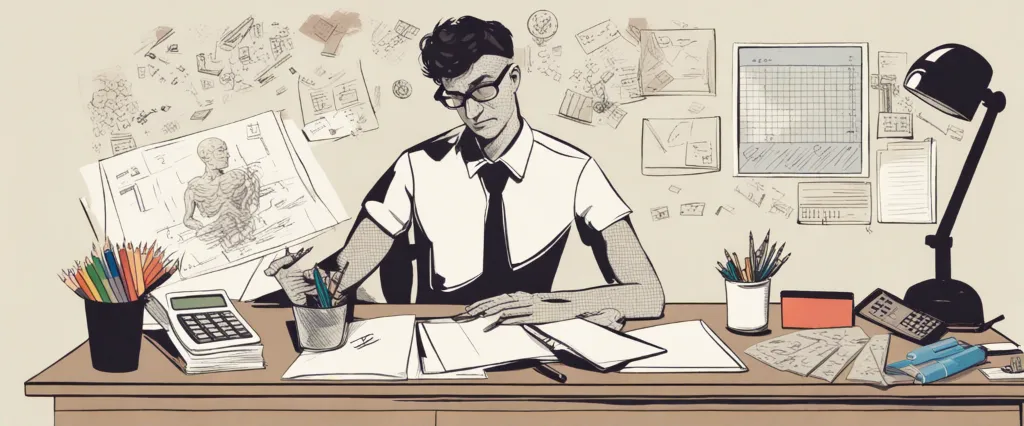Drawing on the Right Side of the Brain is a groundbreaking book written by Betty Edwards that has empowered countless individuals to tap into their creative potential. In this enlightening guide, Edwards presents a unique approach to drawing, highlighting the fundamental shift required to access the right hemisphere of the brain—the seat of intuition, imagination, and artistic expression. Drawing on her extensive experience as an art instructor and researcher, Edwards unlocks the secrets of artistic mastery, demystifying the process and encouraging readers to embrace their innate artistic abilities. This summary explores the key concepts and exercises presented in the book, equipping readers with the tools to unleash their creativity and embark on a transformative artistic journey.
Introduction to Drawing
“Introduction to Drawing” is the first chapter of the book “Drawing on the Right Side of the Brain” by Betty Edwards. In this chapter, Edwards sets the foundation for her revolutionary approach to drawing and introduces the key concepts and theories behind her methodology.
The chapter begins by highlighting a common but erroneous belief that artistic ability is a talent one is either born with or without. Edwards disputes this notion, explaining that drawing is a skill that can be learned and developed by anyone, regardless of natural talent. She argues that the left hemisphere of the brain, responsible for logical and analytical thinking, often interferes with the right hemisphere, which is responsible for creative and intuitive thinking – a hindrance to drawing. Edwards proposes that by learning how to access the right hemisphere of the brain, individuals can overcome this interference and tap into their true drawing potential.
The author also introduces the concept of “drawing on the right side of the brain,” which refers to engaging the creative and intuitive functions of the brain rather than relying solely on analytical thinking. Edwards emphasizes that drawing is essentially a process of perception, and learning to see, rather than just looking, is crucial for accurate representation of the visual world.
Furthermore, the chapter outlines the primary goals and exercises of the book, which include improving observational skills, accurately perceiving the five visual components of drawing (edges, spaces, relationships, lights and shadows, and the whole), developing the ability to recognize and draw individual features, and achieving a general improvement in drawing ability.
Overall, the introduction sets the stage for the rest of the book by debunking the myth of innate artistic talent and demonstrating that anyone can become proficient at drawing by accessing the right hemisphere of the brain and learning to perceive and depict the world from a different perspective.
Perception and the Drawing Process
“Drawing on the Right Side of the Brain” by Betty Edwards explores the connection between perception and the drawing process. The book delves into the idea that everyone has the potential to become skilled at drawing, and it emphasizes the importance of tapping into the right hemisphere of the brain, which is associated with visual and artistic abilities.
Edwards explains that the left hemisphere of the brain, which is responsible for logical thinking and language, often dominates our perception and blocks our ability to accurately represent what we see. By learning how to switch to the right hemisphere, individuals can tap into their natural artistic talents.
The book introduces various exercises and techniques to help readers develop their perception skills and access the right hemisphere of their brain. These exercises aim to improve the ability to see objects in a new light, enabling artists to create more accurate and lifelike drawings.
One of the key concepts discussed in the book is the idea of “seeing.” Edwards argues that drawing is not simply about reproducing what we think an object looks like, but rather about observing the object as if it were seen for the first time. By training the brain to see patterns, shapes, and relationships, artists can break free from preconceived notions and draw more authentically.
Overall, “Drawing on the Right Side of the Brain” offers a comprehensive guide to enhancing artistic abilities. By emphasizing the importance of perception and offering practical exercises, Betty Edwards provides readers with the tools needed to tap into their creative potential and excel in the drawing process.
The Perception of Edges
“The Perception of Edges” is a crucial chapter of Betty Edwards’ book, “Drawing on the Right Side of the Brain.” In this chapter, Edwards explores the concept of how our brain perceives and interprets edges in our visual field.
Edwards begins by explaining that our brain has a natural tendency to simplify what we see by categorizing objects and shapes into recognizable forms. However, this tendency often hinders our ability to accurately observe and draw what is in front of us. Our reliance on symbols and preconceived notions limits our perception of edges, preventing us from capturing the true essence of the subject.
To overcome this limitation, Edwards introduces the concept of “the perception of edges.” She trains readers to see beyond their preconceived notions and truly observe the edges of objects, focusing on their relationships with surrounding shapes and lines. By practicing this skill, individuals can improve their ability to accurately replicate what they see on paper.
Through a series of exercises and demonstrations, Edwards guides readers to turn off the dominant left side of their brain, which processes language and symbolic thinking, and taps into the visual abilities of the right side. By doing so, readers can enhance their perception of edges and subsequently improve their drawing skills.
Ultimately, “The Perception of Edges” delves into the intricacies of human visual processing and provides practical exercises to help readers develop the ability to see and interpret edges accurately in their drawings. This chapter serves as a crucial foundation for the rest of the book, as it sets the stage for further exploration of the brain’s role in artistic perception.
The Perception of Spaces

The Perception of Spaces is an important chapter of the book “Drawing on the Right Side of the Brain” by Betty Edwards. The chapter focuses on how we perceive and understand the spatial relationships between objects and how this understanding affects our ability to accurately draw what we see.
Edwards begins by explaining that the left hemisphere of our brain tends to dominate in perceiving objects, which leads to oversimplification and a lack of attention to spatial relationships. On the other hand, the right hemisphere is responsible for recognizing overall spatial relationships and interpreting the visual world as a whole.
The author guides the reader through several exercises aimed at enhancing the use of the right hemisphere for perceiving space. One exercise involves copying a complicated line drawing upside down, which forces the brain to rely on spatial relationships rather than relying on preconceived ideas about objects. By doing this, the artist can more accurately replicate the proportions and details of the drawing.
Furthermore, Edwards emphasizes the importance of using the “negative space” technique, where artists observe and draw the shapes around objects, rather than focusing solely on the objects themselves. This technique helps the brain make more accurate assessments of proportions and shapes.
In conclusion, the chapter on The Perception of Spaces in “Drawing on the Right Side of the Brain” highlights the significance of spatial perception in drawing. By training the right hemisphere to perceive objects as interconnected elements within a space, artists can overcome the limitations of the left hemisphere’s tendency to oversimplify or distort what is being observed.
The Perception of Relationships
The book “Drawing on the Right Side of the Brain” by Betty Edwards explores the concept of perception and its impact on our ability to draw. Edwards argues that many people struggle with drawing because they rely too heavily on their left brain functions, which control logical thinking and labeling, while neglecting the creative right brain functions responsible for visual perception.
According to Edwards, the left brain’s preference for verbal processing hampers our ability to accurately perceive the visual world. She introduces the concept of “L-mode” thinking, which represents the left brain, and contrasts it with “R-mode” thinking, associated with the right brain. L-mode tends to categorize and label objects, whereas R-mode emphasizes holistic perception.
To teach readers how to tap into their right brain and enhance their drawing skills, Edwards introduces various drawing exercises and techniques. She guides readers to switch from their L-mode thinking to R-mode thinking, encouraging them to observe and analyze visual information differently.
One key aspect of Edwards’ approach is the idea that perception can be learned and trained. By developing the ability to perceive relationships between shapes, spaces, and proportions, readers can become more adept at accurately rendering these elements in their drawings.
Throughout the book, Edwards also covers other related topics, such as overcoming creative blocks, the role of memory in drawing, and the importance of drawing as a means of self-expression. Overall, “Drawing on the Right Side of the Brain” provides readers with a practical and comprehensive guide to unlocking their artistic potential by redefining their perception of relationships.
The Perception of Light and Shadow
Drawing on the Right Side of the Brain by Betty Edwards explores the process of learning how to draw and challenges the conventional belief that artistic ability is solely a talent one is inherently born with. The book emphasizes the potential for anyone to develop artistic skills through a shift in perception and the use of the right hemisphere of the brain.
One of the key aspects Edwards focuses on is the perception of light and shadow. She explains that in order to accurately represent objects and scenes, an artist must first learn to perceive these subtle variations of light and shadow. Through various exercises, Edwards guides readers to observe and analyze the relationship between light and shadow in their surroundings. By doing so, they can gain a deeper understanding of how to translate three-dimensional objects onto a two-dimensional surface.
The book delves into the psychological processes at play when we look at objects. Edwards explains that our left brain hemisphere tends to dominate in perceiving symbols and names, often categorizing objects based on past experiences. However, this approach can hinder accurate drawing as it limits our ability to truly observe the visual world. Edwards encourages readers to tap into the right hemisphere of the brain, which excels at recognizing and understanding spatial relationships, to overcome these limitations.
Through a series of exercises and illustrations, the author teaches readers how to use skills such as upside-down drawing, contour drawing, and negative space perception to shift their perception and enhance their artistic abilities. By training the brain to perceive in a new way, Edwards believes that readers will be able to unlock their creativity and effectively translate their visual observations into meaningful works of art.
Overall, Drawing on the Right Side of the Brain by Betty Edwards is a comprehensive guide for aspiring artists, providing valuable insights into the perception of light and shadow while offering practical exercises to develop artistic skills.
The Perception of Gestalt
In her book, “Drawing on the Right Side of the Brain,” Betty Edwards explores the concept of perception and how it relates to the art of drawing. She introduces the Gestalt principles to explain how our brains process visual information.
Gestalt psychology emphasizes that the brain naturally seeks to organize visual stimuli into meaningful patterns. Edwards demonstrates how our perceptual system often overrides our ability to accurately observe and draw what we see as a whole, instead, relying on symbolic representations of objects. This tendency, she argues, hinders our drawing abilities.
Drawing on the Gestalt principles, Edwards encourages readers to shift their perception and embrace the right hemisphere of their brain, which is responsible for holistic and visual thinking. By tapping into this hemisphere, one can develop better drawing skills by effectively bypassing the dominant left hemisphere, which is more logical and verbal.
Through various exercises and techniques, Edwards guides readers to let go of preconceived notions and embrace the full visual reality around them. She teaches them to see not just individual objects, but the relationships between them and the negative spaces that define them.
Throughout the book, Edwards provides numerous examples and exercises to demonstrate the perceptual shifts required to improve drawing skills. By engaging in activities such as contour drawing, creating upside-down drawings, and practicing with a viewfinder, readers can enhance their perception of lines, shapes, and proportions.
Overall, “Drawing on the Right Side of the Brain” delves into the intricacies of perception and how it affects our ability to draw. By adopting the principles of Gestalt psychology and practicing specific exercises, readers can expand their observation skills and create more accurate and realistic drawings.

Putting It All Together
In the final chapter of “Drawing on the Right Side of the Brain” by Betty Edwards, titled “Putting It All Together,” the author emphasizes the significance of combining the various principles and techniques learned throughout the book. Edwards asserts that by applying these principles, everyone can tap into their right brain functions and achieve more powerful and accurate drawing skills.
She begins the chapter by reminding readers that drawing is primarily a skill, developed through practice and perseverance. It is not an inherent talent that only a special few possess. Edwards encourages individuals to persist in their practice to improve their drawing abilities and overcome any self-doubt.
Edwards then revisits the five basic skills required for drawing: the perception of edges, spaces, relationships, lights and shadows, and the whole or gestalt. By practicing these skills consistently, one can bypass their left brain’s dominant control and access the visual thinking mode of their right brain.
The author also underlines the importance of the “seventh-day reflection” concept. Taking a break from drawing and revisiting your work the next day allows you to see it with fresh eyes and analyze it objectively. This reflection helps identify areas for improvement and highlights progress made over time.
Moreover, Edwards emphasizes that drawing is not a linear process. It involves an interactive and iterative cycle of perceiving, analyzing, and translating what you see onto paper. By embracing this cycle, one can continuously refine their skills and create more accurate and expressive drawings.
In conclusion, “Putting It All Together” emphasizes the consistent practice of the five basic skills, the importance of reflection, and the interactive process of drawing. By applying these principles, individuals can tap into their right brain and unlock their full potential for drawing. Edwards encourages readers to approach drawing with confidence, knowing that through diligent practice and the proper application of techniques, anyone can improve their artistic abilities.
After Reading
In conclusion, “Drawing on the Right Side of the Brain” is a comprehensive guide by Betty Edwards that revolutionizes the way we approach drawing by tapping into the creative capabilities of the right hemisphere. Through various exercises, the book teaches readers how to overcome artistic obstacles, tap into their artistic potential, and develop drawing skills previously thought to be out of reach. Edwards emphasizes the importance of shifting from a left-brain analytical mode to a right-brain perceptual mode, encouraging readers to see and think like artists. By demystifying the process of drawing and offering practical techniques, this book empowers individuals to express themselves artistically and discover a newfound joy in the act of creating visual art. With its combination of theory, exercises, and inspirational testimonies, “Drawing on the Right Side of the Brain” is an invaluable resource for anyone seeking to develop their artistic abilities and see the world through the eyes of an artist.
1. The Artist’s Way” by Julia Cameron: Like “Drawing on the Right Side of the Brain,” this book focuses on nurturing creativity and unleashing artistic potential. Through a 12-week program, Cameron provides exercises and guidance to help readers explore their creative selves and overcome barriers.
2. “Steal Like an Artist” by Austin Kleon: In this book, Kleon encourages readers to look beyond traditional artistic methods and embrace their own unique creative processes. Drawing inspiration from various sources, Kleon shares practical strategies and innovative ideas for kick-starting creativity.
3. “The Creative Habit” by Twyla Tharp: As a renowned choreographer, Tharp offers insights into the creative process and how to cultivate discipline and inspiration. Through anecdotes and exercises, she provides practical advice on developing creativity as a routine habit.
4. “Art & Fear: Observations on the Perils (and Rewards) of Artmaking” by David Bayles and Ted Orland: This book delves into the common fears and challenges faced by artists. Offering guidance and reassurance, the authors explore the artistic journey, helping readers navigate through self-doubt, setbacks, and the challenges of the creative process.
5. “Big Magic: Creative Living Beyond Fear” by Elizabeth Gilbert: Gilbert, the author of “Eat, Pray, Love,” encourages readers to embrace their innate creativity and live a life driven by curiosity and passion. Through personal anecdotes and inspirational advice, she empowers individuals to overcome fear and pursue their artistic aspirations.




